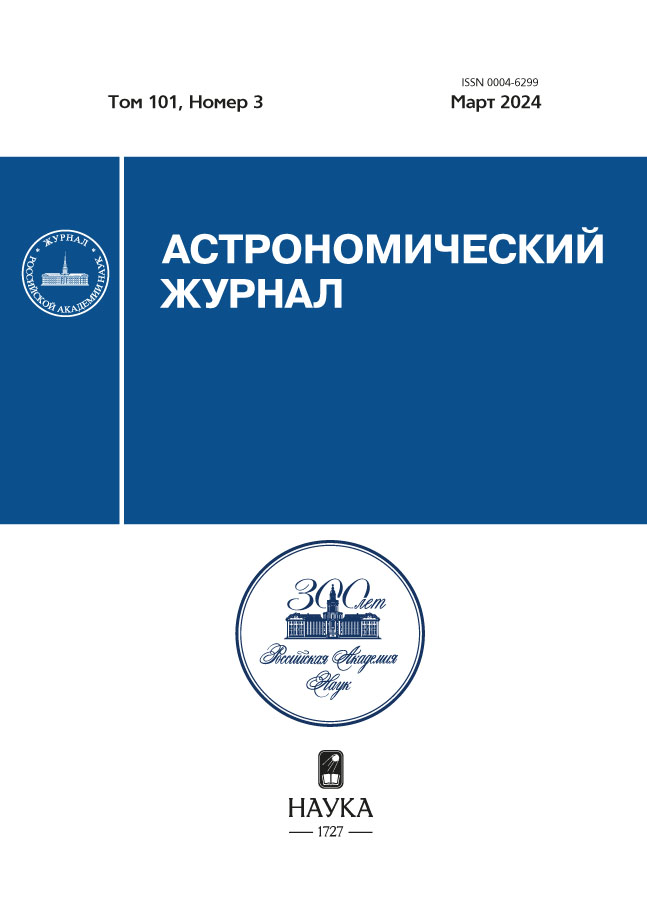Displacement norm in the presence of an inverse-square perturbing acceleration in the reference frame associated with the radius vector
- Авторлар: Sannikova T.N.1
-
Мекемелер:
- Crimean Astrophysical Observatory of RAS
- Шығарылым: Том 101, № 3 (2024)
- Беттер: 284-296
- Бөлім: Articles
- URL: https://cardiosomatics.ru/0004-6299/article/view/647638
- DOI: https://doi.org/10.31857/S0004629924030096
- EDN: https://elibrary.ru/KIENHG
- ID: 647638
Дәйексөз келтіру
Аннотация
The problem of motion of a zero-mass point under the influence of attraction to the central body and a small perturbing acceleration P′ = P/r 2 is considered, where r is the distance to the attracting center, components of the vector P are assumed to be constant in a reference system with axes directed along the radius vector, the transversal and the angular momentum vector. Previously, for this problem, we found equations of motion in the mean elements and formulas for the transition from the osculating elements to the mean elements in the first order of smallness; we neglected second-order quantities. In this work, the Euclidean (root–mean–square over the mean anomaly) displacement norm ||dr||2 is obtained, where dr represents the difference between the position vectors on the osculating and mean orbit. It turned out that ||dr||2 depends only on the components of the vector P (positive definite quadratic form), the semi–major axis (proportional to the second power) and the eccentricity of the osculating ellipse. The norm ||dr||2 is obtained in the form of series in powers of the and in powers of the eccentricity e. The results are applied to the problem of the motion of asteroids under the influence of a perturbing acceleration inversely proportional to the square of the heliocentric distance, in particular, under the influence of the Yarkovsky effect.
Толық мәтін
Авторлар туралы
T. Sannikova
Crimean Astrophysical Observatory of RAS
Хат алмасуға жауапты Автор.
Email: tnsannikova@craocrimea.ru
Ресей, Nauchny, Crimea
Әдебиет тізімі
- Т.Н. Санникова, К.В. Холшевников, Астрон. журн. 96(5), 418 (2019).
- Н. Батмунх, Т.Н. Санникова, К.В. Холшевников, В.Ш. Шайдулин, Астрон. журн. 93(3), 331 (2016).
- И.С. Градштейн, И.М. Рыжик, Таблицы интегралов, рядов и произведений (СПб.: БХВ-Петербург, 2011).
- Small-Body Database Lookup, Jet Propulsion Laboratory NASA, California Institute of Technology, https://ssd.jpl.nasa.gov/tools/sbdb_lookup.html#/.
- Т.Н. Санникова, Астрон. журн. 98(4), 321 (2021).
- D. Vokrouhlický, Astron. and Astrophys. 344, 362 (1999).
- J. Ďurech, D. Vokrouhlický, P. Pravec, J. Hanuš, et al., Astron. and Astrophys. 609, id. A86 (2018).
- Т.Н. Санникова, Астрон. журн. 99(6), 506 (2022).
- К.В. Холшевников, В. Б. Титов, Задача двух тел. Учеб. пособие (СПб.: изд. СПбГУ, 2007).
- Г.М. Фихтенгольц, Курс дифференциального и интегрального исчисления. Т. 2 (М.: Физматлит, 2001).
Қосымша файлдар










